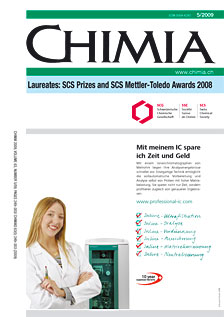About the Electrospray Ionization Source in Mass Spectrometry: Electrochemistry and On-chip Reactions
DOI:
https://doi.org/10.2533/chimia.2009.283Keywords:
Biomolecules, Electrochemistry, Electrospray ionization, Metal ions, MicrochipAbstract
The present work shows that the electrochemical properties of electrospray ionization (ESI) can be used to add functions to the process. As example, we show how the choice of the electrode material can be used to study interactions between metal ions and biomolecules in mass spectrometry (MS). In positive ionization MS, an electrospray device acts as anode, which implies oxidation reactions. Sacrificial electrodes (made of copper or zinc) are used to supply the electrospray current and to produce cations that are able to react on-line with compounds of interest. Thus, the interactions between copper ions and ligands or peptides were investigated by using a copper electrode. Another example is the in situ electrogeneration of a dinuclear zinc(II) complex for the mass tagging of phosphopeptides when working with a zinc electrode. In order to perform these reactions on the same microchip, a dual-channel microsprayer was used, where one channel was dedicated to the tag electrogeneration and the other to the infusion of a phosphopeptides solution. Finally, this dual-channel microsprayer was used to study complexation at liquid-liquid interfaces in biphasic ESI-MS, such as thioether crowns and lead ions or peptides and phospholipids complexes. These examples illustrate the use of electrochemistry and on-chip reactions in ESI-MS analysis.Downloads
Published
2009-05-27
Issue
Section
Scientific Articles
License
Copyright (c) 2009 Swiss Chemical Society

This work is licensed under a Creative Commons Attribution-NonCommercial 4.0 International License.
How to Cite
[1]
M. Prudent, M. Méndez, C. Roussel, B. Su, N. Lion, J. S. Rossier, H. H. Girault, Chimia 2009, 63, 283, DOI: 10.2533/chimia.2009.283.







